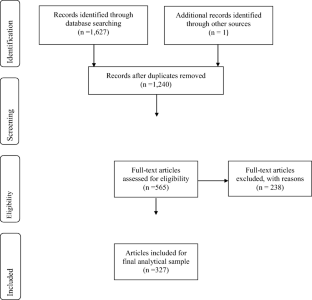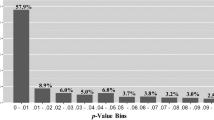Abstract
The field of criminology and criminal justice encompass broad and complex multidisciplinary topics. Most of the research that falls under these areas uses either quantitative or qualitative methodologies, with historically limited use of mixed methods designs. Research utilizing mixed methods has increased within the social sciences in recent years, including a steadily growing body of mixed method research in criminal justice and criminology. The goal of this study was to examine how mixed method designs are being employed within research related to criminal justice and criminology. Our systematic review located 327 mixed method articles published between 2001 and 2017. Findings indicated most criminology and criminal justice research is being conducted within the specialty area of victimology. This study provides an overview of mixed methods research in criminology and criminal justice and also illustrates that most publications are not including methodological concepts specific to mixed methods research (e.g., integration). Along with our systematic review, we offer a series of recommendations to move mixed methods research forward in criminology and criminal justice.


Similar content being viewed by others
References
Aarons, G. A., Fettes, D. L., Sommerfeld, D. H., & Palinkas, L. A. (2012). Mixed methods for implementation research: Application to evidence-based practice implementation and staff turnover in community-based organizations providing child welfare services. Child Maltreatment, 17(1), 67–79.
Anderson, E. (1999). Code of the street: Decency, violence, and the moral life of the inner city. New York: W. W. Norton & Company.
Anderson, V. R. (2015). Introduction to mixed methods approaches. In L. A. Jason & D. S. Glenwick (Eds.), Handbook of methodological approaches to community-based research: Qualitative, quantitative, and mixed methods (pp. 233–241). New York: Oxford University Press.
Bazeley, P. (2018). Integrating analyses in mixed methods research. Thousand Oaks, CA: Sage.
Brent, J. J., & Kraska, P. B. (2010). Moving beyond our methodological default: A case for mixed methods. Journal of Criminal Justice Education, 21(4), 412–430.
Bryman, A. (1988). Quantity and quality in social research. London: Routledge.
Buckler, K. (2008). The quantitative/qualitative divide revisited: A study of published research, doctoral program curricula, and journal editor perceptions. Journal of Criminal Justice Education, 19(3), 383–403.
Burrell, N. A., & Gross, C. (2018). Quantitative research, purpose of. In M. Allen (Ed.), The SAGE Encyclopedia of Communication Research Methods (pp. 1378–1380). Los Angeles: SAGE.
Campbell, D. T., & Fiske, D. W. (1959). Convergent and discriminant validation by the multitrait-multimethod matrix. Psychological Bulletin, 56(2), 81–105. https://doi.org/10.1037/h0046016.
Campbell, R., Fehler-Cabral, G., Bybee, D., & Shaw, J. (2017). Forgotten evidence: A mixed methods study of why sexual assault kits (SAKs) are not submitted for DNA forensic testing. Law and Human Behavior, 41(5), 454–467.
Campbell, R., Goodman-Williams, R., Feeney, H., & Fehler-Cabral, G. (2020). Assessing triangulation across methodologies, methods, and stakeholder groups: The joys, woes, and politics of interpreting convergent and divergent data. American Journal of Evaluation, 41(1), 125–144.
Cohen, J. (1960). A coefficient of agreement for nominal scales. Educational and Psychological Measurement, 1, 37–46.
Copes, H., Beaton, B., Ayeni, D., Dabney, D., & Tewksbury, R. (2020). A content analysis of qualitative research published in top criminology and criminal justice journals from 2010 to 2019. American Journal of Criminal Justice, 45, 1060–1079. https://doi.org/10.1007/s12103-020-09540-6.
Copes, H., Brown, A., & Tewksbury, R. (2011). A content analysis of ethnographic research published in top criminology and criminal justice journals from 2000 to 2009. Journal of Criminal Justice Education, 22(3), 341–359.
Creswell, J. W. (2009). Research design: Qualitative, quantitative, and mixed methods approaches (3rd ed.). Los Angeles: Sage.
Creswell, J. W. (2013). Qualitative inquiry & research design: Choosing among five approaches (3rd ed.). Sage.
Creswell, J. W., Klassen, A. C., & Plano Clark, V. L. (2011). Best practices for mixed methods research in the health sciences. Washington, DC: National Institute for Health https://www.obssr.od.nih.gov/wp-content/uploads/2018/01/Best-Practices-for-Mixed-Methods-Research-in-the-Health-Sciences-2018-01-25.pdf.
Creswell, J. W., & Plano Clark, V. L. (2018). Designing and conducting mixed methods research (3rd ed.). Thousand Oaks, CA: Sage.
Crow, M. S., & Smykla, J. O. (2013). A mixed methods analysis of methodological orientation in national and regional criminology and criminal justice journals. Journal of Criminal Justice Education, 24(4), 536–555.
Culbert, G. J., Bazazi, A. R., Waluyo, A., Murni, A., Muchransyah, A. P., Iriyanti, M., Finnahari, Polonsky, M., Levy, J., & Altice, F. L. (2016). The influence of medication attitudes on utilization of antiretroviral therapy (ART) in Indonesian prisons. AIDS and Behavior, 20(5), 1026–1038.
Curry, L., & Nunez-Smith, M. (2015). Mixed methods in health sciences research: A practical primer. Thousand Oaks, CA: Sage.
Denzin, N. (1978). Sociological methods. New York, NY: McGraw-Hill.
Eadie, D., MacAskill, S., McKell, J., & Baybutt, M. (2012). Barriers and facilitators to a criminal justice tobacco control coordinator: An innovative approach to supporting smoking cessation among offenders. Addiction, 107(2), 26–38.
European Commission JRC. (2007). Quantitative versus qualitative methods. Retrieved from http://forlearn.jrc.ec.europa.eu/guide/4_methodology/meth_quanti-quali.htm.
Fàbregues, S., & Molina-Azorín, J. F. (2017). Addressing quality in mixed methods research: A review and recommendations for a future agenda. Quality and Quantity, 51, 2847–2863.
Greene, J. C., & Caracelli, V. J. (Eds.). (1997). Advances in mixed-method evaluation: The challenges and benefits of integrating diverse paradigms: New directions for evaluation, 74. San Francisco: Jossey-Bass.
Greene, J. C., Caracelli, V. J., & Graham, W. F. (1989). Toward a conceptual framework for mixed-method evaluation designs. Educational Evaluation and Policy Analysis, 11(3), 255–274.
Hart, L. C., Smith, S. Z., Swars, S. L., & Smith, M. E. (2009). An examination of research methods in mathematics education (1995–2005). Journal of Mixed Methods Research, 3(1), 26–41.
Heap, V., & Waters, J. (2019). Mixed methods in criminology. Routledge.
Hesse-Biber, S., & Johnson, R. B. (2013). Coming at things differently: Future directions of possible engagement with mixed methods research [Editorial]. Journal of Mixed Methods Research, 7(2), 103–109.
Hovey, A., Rye, B. J., & Stalker, C. A. (2013). Factors influencing perceptions of abuse victims: Do therapists’ beliefs about sexual offending affect counseling practices with women? Journal of Child Sexual Abuse, 22, 572–592.
Hovey, A., Stalker, C. A., & Rye, B. J. (2014). Perpetrators of sexual abuse and considerations for treatment. Asking women survivors about thoughts or actions involving sex with children: An issue requiring therapist sensitivity. Journal of Child Sexual Abuse, 23, 442–461.
Howe, K. R. (2016). Against the quantitative-qualitative incompatibility thesis or dogmas die hard. Educational Researcher, 17(8), 10–16.
Howell Smith, M. C., & Shanahan Bazis, P. (2020). Conducting mixed methods research systematic methodological reviews: A review of practice and recommendations. Journal of Mixed Methods Research. https://doi.org/10.1177/1558689820967626.
Islam, F., & Oremus, M. (2014). Mixed methods immigrant mental health research in Canada: A systematic review. Journal of Immigrant Minority Health, 16, 1284–1289.
Johnson, R. B., & Onwuegbuzie, A. J. (2004). Mixed methods research: A research paradigm whose time has come. Educational Researcher, 33(7), 14–26.
Johnson, R. B., Onwuegbuzie, A. J., & Turner, L. A. (2007). Toward a definition of mixed methods research. Journal of Mixed Methods Research, 1(2), 112–133.
Kleck, G., Tark, J., & Bellows, J. J. (2006). What methods are most frequently used in research in criminology and criminal justice? Journal of Criminal Justice, 34, 147–152.
Maruna, S. (2009). Mixed method research in criminology: Why not go both ways? In A. R. Piquero & D. Weisburd (Eds.), Handbook of Quantitative Criminology (pp. 123–140). New York: Springer.
Miller, H. V., Miller, J. M., & Barnes, J. C. (2016). Reentry programming for opioid and opiate involved female offenders: Findings from a mixed methods evaluation. Journal of Criminal Justice, 46, 129–136.
Moher, D., Liberati, A., Tetzlaff, J., Altman, D. G., & The PRISMA Group. (2009). Preferred reporting items for systematic reviews and meta-analyses: The PRISMA statement. PLoS Medicine, 6(7), 1–6.
Molina-Azorin, J. F., & Fetters, M. D. (2016). Mixed methods research prevalence studies: Field-specific studies on the state of the art of mixed methods research. Journal of Mixed Methods Research, 10(2), 123–128. https://doi.org/10.1177/155868981663670.
Plano Clark, V. L., & Ivankova, N. V. (2016). Mixed methods research: A guide to the field. Thousand Oaks, CA: Sage.
Shaw, C. R. (1966). The jack-roller: A delinquent boy’s own story. University of Chicago Press.
Sullivan, C. J., & Maxfield, M. G. (2003). Examining paradigmatic development in criminology and criminal justice: A content analysis of research methods syllabi in doctoral programs. Journal of Criminal Justice Education, 14(2), 269–285.
Tashakkori, A., & Creswell, J. W. (2007). The new era of mixed methods [editorial]. Journal of Mixed Methods Research, 1(3), 207–211.
Tashakkori, A., & Teddlie, C. (1998). Mixed methodology: Combining qualitative and quantitative approaches. Thousand Oaks, CA: Sage.
Testa, M., Livingston, J. A., & Vanzile-Tamsen, C. (2011). Advancing the study of violence against women using mixed methods: Integrating qualitative methods into a quantitative research program. Violence Against Women, 17(2), 236–250.
Tewksbury, R., DeMichele, M. T., & Miller, J. M. (2005). Methodological orientations of articles appearing in criminal justice’s top journals: Who publishes what and where. Journal of Criminal Justice Education, 16(2), 265–279.
Tewksbury, R., Dabney, D. A., & Copes, H. (2010). The prominence of qualitative research in criminology and criminal justice scholarship. Journal of Criminal Justice Education, 21, 391–411.
Wright, R. T., & Decker, S. H. (1997). Armed robbers in action: Stickups and street culture. Boston: Northeastern University Press.
Acknowledgements
We greatly appreciate Christina Poole’s assistance with coding.
Author information
Authors and Affiliations
Corresponding author
Additional information
Publisher’s Note
Springer Nature remains neutral with regard to jurisdictional claims in published maps and institutional affiliations.
Supplementary Information
ESM 1
(DOCX 38 kb)
Rights and permissions
About this article
Cite this article
Wilkes, N., Anderson, V.R., Johnson, C.L. et al. Mixed Methods Research in Criminology and Criminal Justice: a Systematic Review. Am J Crim Just 47, 526–546 (2022). https://doi.org/10.1007/s12103-020-09593-7
Received:
Accepted:
Published:
Issue Date:
DOI: https://doi.org/10.1007/s12103-020-09593-7




